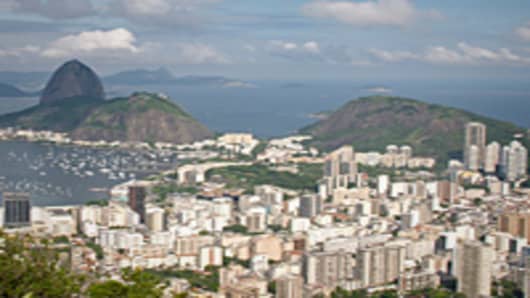A Brazilian plan for a “bullet train” linking Rio de Janeiro and São Paulo is attracting strong foreign interest, despite heavy criticism and three failed attempts to pull in investors.
Public submissions for the first phase of the project, whose total value a government report estimates at R$35bn ($17.3 billion), close on Monday with a tender document to be released next month.
Hearings on the proposal last week were attended by South Korea’s Hyundai and Japan’s Mitsui , said the Brazilian business newspaper Valor Econômico. It also reported that 19 international and local railway groups were preparing consortia, from France’s SNCF to Spain’s Renfe.
“If you look at the rising levels of road and air traffic between Rio and São Paulo, it's clear that a high-speed rail is the logical next step,” said a spokesperson for Canada`s Bombardier, one of the world`s biggest builders of fast trains, which is also planning to participate.
In a country that lacks basic infrastructure, including rail connections between its congested cities and their airports — it can take twice as long to reach the airport in São Paulo as the actual flying time to Rio — the high-speed rail project is viewed by critics as a gross extravagance.
For the total cost of the project, Brazilcould build eight new much-needed subway lines in Rio and São Paulo, where increasing car ownership is worsening chronic traffic jams.
“In the long term, it is important for Brazil to have a high-speed rail network, but there are more immediate priorities,” said Richard Dubois, infrastructure partner at PwC professional services in São Paulo.
The proposed rail project would link Rio with the greater metropolitan regions of São Paulo and neighboring Campinas, whose total regional population is more than 22 million. The 411-kilometer (274 mile) trip between Rio and São Paulo — on a train travelling at speeds of up to 300kph (186 mph) — would take about 90 minutes, while the full journey to Campinas, 100km (62 mile) longer, would take almost an hour more.
Authorities will hold an auction next year to choose the concessionaire and the operator of the train before moving on to award the civil works projects — expected to account for the bulk of the venture's capital expenditure costs.
The scheme faces challenges as it will pass through mountain ranges, with 53 percent of the total cost expected to be spent on tunnels and bridges.
Earlier attempts to auction the project failed because the government expected private bidders to assume most of the risk for the enormous civil works involved, analysts say.
Now the government is planning to take responsibility for the civil works, including the tunnels and bridges. A concessionaire and operator will be selected separately along with a supplier of rolling stock.
“This time the government has come up with a project that is more feasible and attractive to the private sector,” said Mr. Dubois.
He says operators are expected to seek a required return above inflation of about 8 to 10 percent a year, compared with 15 to 20 percent previously, reflecting the lower risk of this proposal.
A 2009 government study by consultants Halcrow and Sinergia estimated the cost of an economy ticket on the train at R$200, compared with R$400 for flying, with the train journey time from Rio to São Paulo slightly shorter than the total time if using an airline.
In fact, air congestion is growing in Brazil, say backers of the rail project, with return flights between Rio and São Paulo costing as much as R$1,600 — one of the most expensive routes per kilometer in the world.
Critics point out that rail projects often hit cost over-runs, a particular risk in Brazil where the price tags of large projects can balloon to double and triple the original estimates, and that passenger numbers are usually lower than planned, leading to high government subsidies.
“We rate rail systems round the world and not many of them make money from the fare box,” said Art Simonson, head of Latin American infrastructure with Standard & Poor’s.
But proponents say the time is right for Brazil to begin working on a high-speed train, especially given the long lead time, with operations not expected to start until about 2019.
“These projects are more like a marathon,” said the Bombardier spokesperson.


